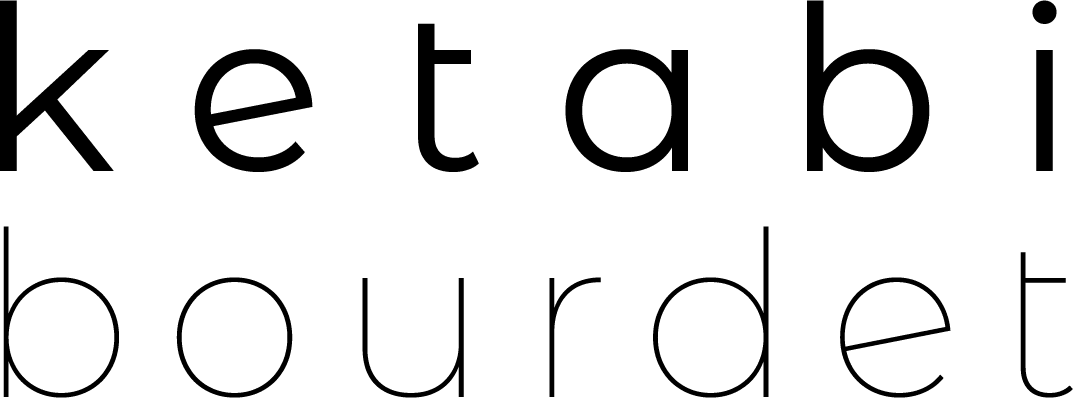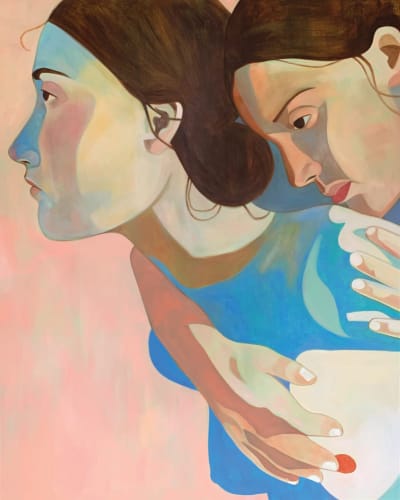The French artist tells us about her love of colour, how the pandemic has affected her creativity and refusing to become a social media 'brand'.
If Inès Longevial could only be alive for one moment of the day it would be as the sun sets. When the light turns warm, the sky becomes a mellow palette of reds, oranges, yellows, pinks and bluish mauves, and the shadows take on a life of their own. In homage to this fleeting moment, the French painter, whose portraits of women are saturated in nostalgia, has named her latest exhibition at Ketabi Projects in Paris: Before the sun sinks low.
On show are paintings of the female form — naked bodies and faces — in soft shades of sundown, much like the subjects she learnt to draw when she was a little girl. At first, her illustrations of nude, grown women were a “child fantasy,” she says, “a projection of oneself in a dreamed future.” But that soon changed with adulthood. Now, Inès paints her everyday reality. The images have become a diary of her life and emotions, close up facial expressions that betray internal battles and joy.
“Being a woman is central to my identity,” Inès adds, “it is not only what I know best of myself, but what I want to pay tribute to.” The artist is close to all the women in her life — her mother, sister, grandmothers, aunts, cousins and girlfriends — who she catches herself looking at from the sidelines. In her eyes, “they are witches, fairies and magicians,” mythical beings that she loves to observe deeply, admire for their differences, and absorb their knowledge and opinions.
Her work is undoubtedly a celebration of femininity and the power of womanhood, but Inès often finds the label diminutive. “The word femininity is a trap for me as it is often reduced to a concept and images, which are prejudiced and aged,” she says. “Most of the time, I do not feel at all in the incarnation of my femininity. I feel badly in my skin, out of step between the inside and outside… When I see my girlfriends, my sister or my mother, I see that we are all extremely strong, but always doubting our image — afraid of the difference between who we want to be and what is expected of us.”
For too long, society has told women to present themselves as thin, beautiful, passive, dependent, nurturing and empathetic — judging them on looks and the ability to raise children rather than their achievements. “One is not born, but rather becomes a woman,” wrote French feminist and theorist Simone de Beauvoir, addressing the high standards and homogenisation placed on women by the mainstream.
In the early 60s, Betty Friedan called for the “drastic reshaping of the cultural image of femininity,” which she regarded as key to women’s subjugation in The Feminine Mystique. But the struggle to dismantle the toxic archetype of femininity has continued into the 21st century.
“I think we have to embrace our uniqueness and feel the power that this gives us, not wasting time being afraid,” Inès says. She paints light gracefully bouncing off collarbones or casting shadows on half a face, her short, fluid brushstrokes skillfully revealing women that are deep in thought. Their penetrating gazes are strong, steady and powerful.
Inès’ portraits capture the essence of a face, fixed in a moment, “as if the body was a landscape.” Instead of being inspired by a particular person, the artist takes her cues from colour. “I’d like to eat, kiss, caress, lick colours. Live in colours. That’s what awakens and animates me,” she says. In the southwest of France, where the artist grew up, the light was vivid over the countryside that surrounded her. What bothers her most about Paris, where she currently lives, is its “light blue jeans colour.” “Even the sunset is never really on fire,” she says.
For inspiration Inès looks to Pablo Picasso, for his sense of freedom and constantly shifting style, and the Argentinian surrealist painter Leonor Fini, who is known for her portrayal of powerful and erotic women. She admires Spanish director Pedro Almodóvar’s careful observation of women and use of colour, finds solace in the work of musicians like Joni Mitchell and Leonard Cohen, and takes words of wisdom from Julian Casablancas, lead singer of the Strokes.
“My favourite songs have always had this double reading: the first time you listen they give you the impression of being happy and joyful and the second time they are melancholic and deep,” she says. “Almost everything I like gives me this feeling. Faces are perhaps the first thing I saw when I was a child, I was very sensitive to different states of mind.”
Inès has developed a style that’s earned appreciation among more than 300k Instagram followers. But like many contemporary artists, navigating the world of social media can be a challenge: “Sometimes I feel like I have to post inspirations, paintings, because I have the feeling that I’m expected, as if I had to go to a party when I don’t want to see the people there.”
Her goal is to continue painting, not to create a brand, she says. “My work has nothing to do with what must be done or what I have to do to please or match a time and ideologies. I just do what I want to do. Freedom is my only rule.”
During the pandemic, Inès spent eight months on a scrapbook of the last two years of her life and work, which she self-published in the monograph Longevial in November. Presented chronologically it documents her travels through a series of sketches and paintings that sit between notes, doodles, songs, souvenirs and photographs. It’s indulgent, nostalgic and raw, “as if I was opening my secret box to the viewer,” she says.
In a year of uncertainty, it’s a joyful celebration of the weird and wonderful, the touristy and the obscure: flowers in Manhattan, the chroma neon colours of Vietnam, a fry up in London with a post-it that reads, “I overthink a lot,” and working from her studio in Brooklyn, where she was able to realise her dream of painting and owning a studio in New York for a short period of time.
“At first it was difficult to paint in this new sad and sick world, but then it came out like an incessant flow,” Inès reflects on creating during the pandemic. “The summer came for a couple of months of recklessness, and, finally, the last months, which I find more complicated. I still paint and draw, but I feel a lot of frustration. I don’t sleep very well, I wake up 200 times at night. My painting is indissociable from what I live in my life, so what we live is deeply linked to what I paint.”


